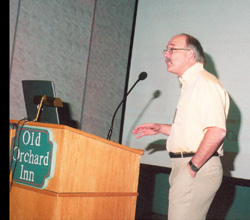
The southern interior of British
Columbia may have an extended growing season compared to the rest of
Canada, but its very dry climate can impose constraints on apple
production, including organic systems.
 |
| Dr. Gerry Neilsen |
The southern interior of British Columbia may have an extended growing season compared to the rest of Canada, but its very dry climate can impose constraints on apple production, including organic systems.
In the province, organic horticulture is practiced on about 20 farms, covering about 8,800 ha, and is worth $20 million. Organic fruit production accounts for 614 ha of the total organic acreage, with apples and pears representing 325 ha.
Dr. Gerry Neilsen, a research scientist at Agriculture and Agri-Food Canada’s Summerland research station, notes that while the area’s growing season may be seven months long, it only receives, on average, about 168 millimetres of rain.
Therefore, water is a concern and irrigation is essential. “We’re trying to computerize it,” explains Dr. Neilsen.
But water isn’t the only issue facing B.C. growers. During the Ice Age, the interior of the province was glaciated. When the glacier receded, the resulting orchard soils were sandy loam with low organic matter, says Dr. Neilsen. Due to this thin topsoil layer, only shallow tillage can be done around the region’s apple trees. Because of this, there is potential for tree root damage and weed management can be a big problem.
To help alleviate these production problems, researchers with AAFC are currently investigating the use of irrigation scheduling and mulching within tree rows, including wood chips.
Mulching
Summerland researchers have been testing various soil amendments within orchards in a bid to conserve water resources while battling weed pressure and promoting tree health and production. Materials examined included a waste paper slurry, fish fertilizer, plus various composts comprised of dairy, hog and poultry manure. Each met with varying degrees of success.
While the waste paper slurry did provide some weed suppression and even helped control the population of root lesion nematodes in the soil, Dr. Neilsen admits its performance was imperfect. The fish fertilizer was also found lacking as it did not provide enough vigour to the trees. As well, with all of the mulches and composts, it was difficult to define which nutrients each of the composts provided to the orchard.
“We have all these organic composts but they all have different properties,” says Dr. Neilsen. “We have to understand how fast they release their nutrients.”
Even with these drawbacks, researchers observed numerous benefits in mulching irrigated soils. Evapotranspiration from the mulched surface decreased, resulting in an increase to the soil’s moisture content and an increase in its rate of carbon sequestration, therefore doubling the soil’s carbon content. Compost also changed the soil’s physical properties and water infiltration capacity while more nitrogen for the soil was derived from the dairy, hog and poultry manure in varying levels.
Dr. Neilsen stresses that additional research still needs to be done on composts, adding the use of compost and drip irrigation will change the phosphorus concentration of orchard soils. “You have to look at your water delivery as well as your fertigation systems.”
As a result, Summerland’s researchers continue to examine ways to improve an orchard’s use of nitrogen and phosphorous through the use of organic amendments and the refinement of irrigation techniques and controls.
Disease prevention and pest control
Of course, not everything in B.C.’s southern interior region is negative to organic apple production. One of the region’s blessings is its lower disease pressure. Apple scab is a minor problem “although we do have more fire blight and mildew, probably because of a shift of cultivars,” says Dr. Neilsen. As a result, Summerland researchers are working on a kit for growers that can rapidly identify the area’s five major orchard diseases, including fire blight, powdery mildew and apple scab, before they appear.
In the area of pest control, major insect problems for the southern interior are usually the result of codling moth and leafroller infestations, although new pests have emerged in recent years with the importation of European rootstocks and tighter controls on chemical sprays.
The area’s sterilized codling moth program is continuing following a recent grower opinion vote by the B.C. Fruit Growers’ Association. The program has been in place since 1992, as is supplemented with tree banding, pheromones and viral controls. After 10 years of trials in five organic orchards, codling moth numbers have been reduced, Dr. Neilsen says.
Over the past three years, Summerland researchers, in comparative trials, have also been examining pheromone use, conventional insecticides and no controls on leafroller populations. “You can see a certain amount of success with biological controls,” says Dr. Neilsen. “It is not 100 per cent.”
Summerland, he adds, is also examining bio-controls as a means of reducing blue and grey mould outbreaks in controlled storages, specifically through applying a bacterial antagonist to the picked fruit.
Print this page